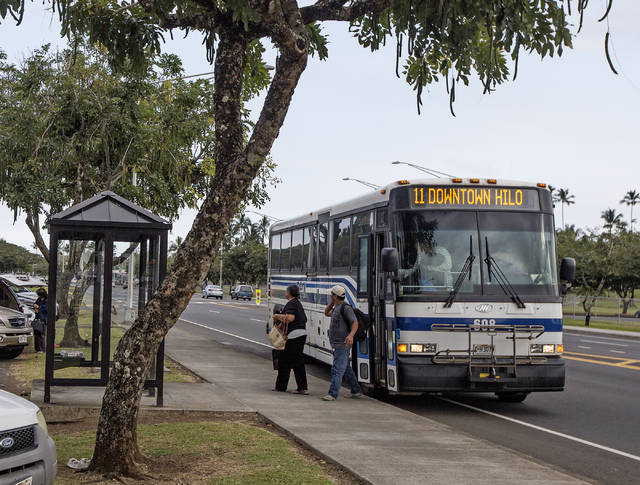More reliable buses, more routes and better coordination are coming to the county transit system, if recommendations of a master plan discussed Monday evening are implemented.
More than 25 people, several in wheelchairs, attended the meeting at Aupuni Center in Hilo, the last of six public meetings on the latest draft of the plan. The project so far has been a year and a half in the making.
The ambitious 10-year plan incorporates suggestions from the public through prior meetings and comments, and makes the Hele-On bus system more user friendly and convenient. But funding the project has yet to be worked out.
“You can’t get something for nothing,” said Cheryl Soon, a consultant with Honolulu-based consulting firm SSFM International. “You can’t have the expansion of the plan without money.”
The current system costs $14.3 million annually to operate. Consultants recommend that be increased to $15.3 million in the fiscal year that starts July 1, then $16 million in 2019-20, $19.5 million in 2020-21 and $19.9 million in 2021-22. Federal grants and fares defray a small percentage of that.
Soon said the consultants are recommending no bus fare increase for at least three years.
There will be a need for an “emergency infusion” of money to buy buses, however, Soon said. The county will need a total of 55 buses within 10 years. It currently has 19, she said.
The county should have been buying five or six new buses every year, but that practice lapsed, leaving an aging fleet that often breaks down.
The plan has five goals: make riding transit easier, reliable and more desirable than other options; create a transit system to serve the employment and social needs of all people; implement technology to provide real-time transportation information; create transportation hubs and bus stops with amenities that provide rider comfort and safety and that help support community and village gathering places; and phase system implementation in a fiscally sustainable manner.
Among the proposed changes to be phased in during the next 10 years:
• Hubs would be created in Kona, Waimea, Keaau and Pahoa, with “spokes” leaving from the hubs to serve nearby communities.
• Service would be added to the Ellison Onizuka Kona International Airport. Four Kona-oriented circulator routes would replace the current Intra-Kona service. Kona also would get a maintenance facility.
• New service would be added in Hawaiian Paradise Park to serve Shower Drive and the future park and regional center on Kaloli Drive. One new trip for a total of four trips would be provided to Kalapana via the Red Road, operating in alternating directions.
• On-demand paratransit services would be added in some areas, as well as reservation-based flex service, express routes and Sunday service on some routes.
Consultants also are recommending a van pool subsidy program and expanding the current taxi voucher system and bike share program. The taxi program currently is only in Hilo, while the bike share program is only in Kona.
Consultants acknowledged that expanded bike programs would be reliant on other improvements, such as bicycle lanes or sidewalks.
“It’s kind of dangerous for people to have these bikes and ride them,” said former Hilo Councilman Dennis “Fresh” Onishi.
Federal grants for six new smaller buses were recently approved.
The 15- to 26-seat buses will be used for regular routes, supplementing larger buses that run the long hauls. The county will pay 20 percent of the cost of each bus, while the federal grant pays 80 percent.
The buses are estimated at $120,000 to $140,000 each.
Consultant Linda Frysztacki said the group noticed early on the timing of the routes hasn’t kept up with changes in traffic.
“The buses at most should be five or six minutes late,” Frysztacki said. “Not 30 minutes late, not 40 minutes late.”
Most riders pay a fare of $1 or $2 each way, but the amount isn’t nearly enough to cover the program. An estimated 750,000 people ride the Hele-On system annually, at an estimated cost to taxpayers of $16.01 each.
The public can view the 164-page draft master plan and submit comments through April 30 by visiting http://heleonmasterplan.com/.
Email Nancy Cook Lauer at ncook-lauer@westhawaiitoday.com.



